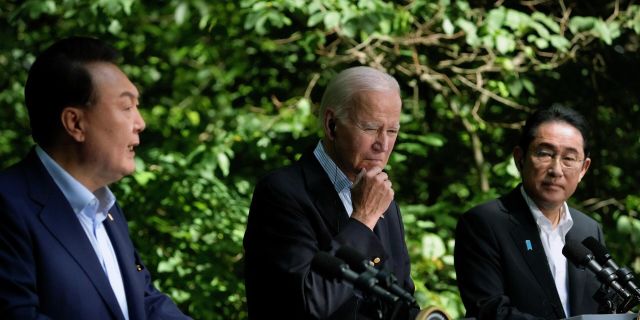The United States failed to create a trilateral military alliance with Japan and South Korea, directed against China, writes Cumhuriyet. Washington is struggling to contain Beijing, but due to the weakening hegemony, it cannot get the desired results, the author of the article notes.
Mehmet Ali Guller
The United States has been trying for some time to unite its two partners, Japan and South Korea, into a trilateral alliance, in the center of which they themselves are. America is already militarizing these countries and inviting them to NATO summits. And on August 18 of this year, Biden received the Japanese and South Korean leaders at Camp David.
So, did the meeting result in an alliance that could be called "Asian NATO"?
Not an alliance, but a partnership
Judging by the joint statement, the result at Camp David was not a trilateral union, but a trilateral partnership. Of course, partnership is also important, but we also emphasize the inability of the United States to form an alliance, despite all efforts, in the context of the global struggle for power.
On the other hand, the declaration on trilateral partnership, agreed by US President Joe Biden, South Korean President Yun Suk-el and Japanese Prime Minister Fumio Kishida, clearly demonstrates the main goal of the United States. The communique takes aim at China, the Democratic People's Republic of Korea (North Korea) and Russia.
Therefore, the trilateral partnership was interpreted as an attempt to militarize the region and turn it into a field of geopolitical struggle. Wang Winbin, the official representative of the Ministry of Foreign Affairs of the People's Republic of China, regarded the partnership as "an attempt to form alienation groups, transfer inter-bloc confrontation and military blocs to the Asia-Pacific region."
Triangles, Quadrilaterals, Pentagons USA
Since the United States declared China its main rival, they have been trying to pursue a strategy of containing this country in the Asia-Pacific region. And for this, they strive to build triangular, quadrangular, pentagonal partnerships and chain them to each other.
- "Five eyes". There was already a Cold War organization in the region. This association of the United States, Great Britain, Canada, Australia and New Zealand is essentially an intelligence partnership.
- QUAD (Quadrilateral Security Partnership). The quadrilateral partnership formed by the United States with India, Japan and Australia in 2007 did not go beyond the "strategic security dialogue".
The overall picture
The US wants to surround China with a wide arc starting from India and stretching to Japan. However, they have not yet been able to force India to accept this.
Therefore, the US is now trying to build a military front stretching from Australia to Japan and South Korea. To do this, they want to expand AUKUS at the expense of New Zealand, make Japan and South Korea allies, and to establish partnerships between these two clusters that will create a base on the Pacific islands. This was the aim of the last visit of the Blinken– Austin duo to the Pacific Islands and the agreement they concluded here with Papua New Guinea.
Yes, all this is the filled part of the glass, and in the empty part is India, which does not accept inclusion in the American strategy, the fact that the United States could not create a trilateral alliance with Japan and South Korea and agreed to a trilateral partnership, New Zealand's refusal to accept an invitation to AUKUS, as well as the fact that most Pacific islands are against the transformation of the region into a geopolitical force field.
Thus, the United States is taking steps in the Asia-Pacific region to maintain an "exploitative order, the rules of which they write themselves," but because of the weakening hegemony they cannot achieve the desired results. Therefore, the overall picture does not change, a new multipolar world is being built.
Author: Mehmet Ali Guller

